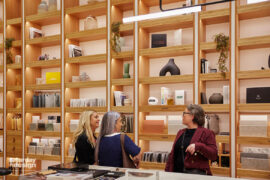New technologies like virtual city models will fundamentally change the city and life in it. What is the role of the self in such schemes? Yvonne Xu writes for Cubes 87.

Screen captures of the virtual Tiong Bahru environment used by the ETH Future Cities Laboratory for the Bike to the Future exhibition last year.Image courtesy of ETH Future Cities Laboratory
September 13th, 2017
What is exciting about Virtual Singapore, targeted for launch next year, is that it is both a representative and a presentive model – it is not just another model of a city, it is a new model for one.
Twinned as an open-to-all, three-dimensional city model and a dynamic and collaborative real-time data platform, it will powerfully change the ways Singapore is planned, designed and used. The platform promises, among many new possibilities, the participatory shaping of the city.
In considering such opportunities and implications, one recalls Jane Jacobs: her idea that “cities have the capability of providing something for everybody, only because, and only when, they are created by everybody.”In the context of smart cities, the Jacobsian ‘everybody’ is refigured with new relevance; ‘everybody’ might now be constituted by big data.
The balance between privacy, security and freedom is another elephant in the room. The security and freedom of the individual are often first concerns. The virtual or the smart city, whose workings and whose life are both placed under dataveillance such that it is self-monitoring, makes for the ultimate urban panopticon.
Is the individual subject to the asymmetrical surveillance of the Foucauldian kind in which “[the individual] is seen, but he does not see; he is an object of information, never a subject in communication”[i]?
Proponents of Virtual Singapore assure that this would not be the case. Data will be anonymised. And while only select groups (government, academia and private-sector agencies) would be able to use the platform upon its launch, everybody – “the public, private, people and research sectors”[ii] – would eventually gain access.
The ‘community’ has also been identified as a stakeholder and an engaged participant. A Virtual Singapore press release states that “communities will be able to co-create innovations to improve the city environment and their neighbourhoods”[iii] in scenarios including having residents flag faulty communal facilities and make collective decisions such as the colour of a HDB block. This suggests that rather than being passive and monitored, residents would have opportunities to engage in active citizenry.
Challenges could be, on one hand, in digital inclusion (‘everybody’ should include non-digital natives and the have-nots who may not possess the means to use such progressive and ever-updating services) and, on the other, the right of individuals to opt out.
Read the complete article in Cubes 87!
[i] Foucault, Michel. Discipline & Punish: The Birth of the Prison. New York: Vintage Books 1995.
[ii] Virtual Singapore – A 3D City Model Platform For Knowledge Sharing And Community Collaboration. Press Release. National Research Foundation, Prime Minister’s Office, Singapore, 2014. https://www.nrf.gov.sg/programmes/virtual-singapore/media-resources
[iii] Ibid.
INDESIGN is on instagram
Follow @indesignlive
A searchable and comprehensive guide for specifying leading products and their suppliers
Keep up to date with the latest and greatest from our industry BFF's!

A curated exhibition in Frederiksstaden captures the spirit of Australian design
The new range features slabs with warm, earthy palettes that lend a sense of organic luxury to every space.
The internet never sleeps! Here's the stuff you might have missed

Saturday Indesign lit up the CBD and South Melbourne with design, wellness, hospitality, and community in a day full of creativity and connection.

Merging residential living with the retail experience, the latest project from In Addition breathes new life into shopping for the home.